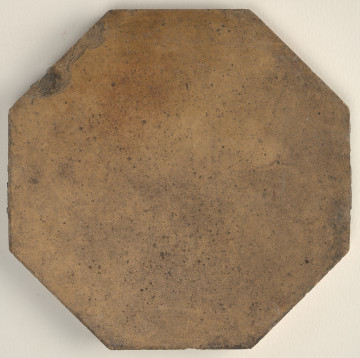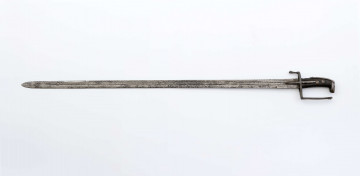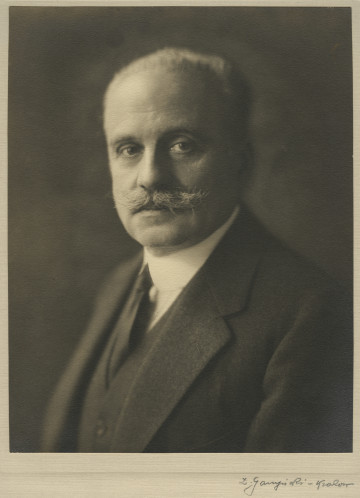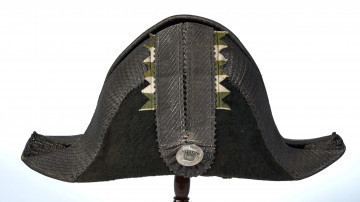
Floor tile
1850 — 1900
Museum of the history of Polish Jews
The floor tiles come from the Dziewulski and Lange ceramics factory in Opoczno are an extraordinary collection which enriches the POLIN Museum's collection with traces of pre-war Warsaw. The first collection consisting of only two tiles is connected to the history of Jewish settlement in Warsaw's Praga district. The tiles most probably come from the now defunct synagogue - converted by the Germans into a dehydration facility, thanks to which it managed to survive the Second World War. After the war, the synagogue was initially listed in the register of historical monuments, but no one made any effort to preserve it. In 1961 it was demolished, the demolition took place at a very fast pace, leaving traces of foundations. The floor tiles that survived from the rubble of the building were found by students while cleaning the area after the temple. As Beata Chomątowska rightly notes in her article Okruchy pamięci(Slivers of memory) ("Znak" 2017, no. 745, pp. 6-13) the tiles resemble those of the Wilhelm Landau Bank building at 38 Senatorska Street in Warsaw, located in close proximity to the Great Synagogue in Tłomackie.
Jews had inhabited Praga since the end of the 18th century. The history of the synagogue's establishment is unclear - it probably existed here from around 1780 and suffered considerably during the Kościuszko Uprising. After 1794, Szmul Zbytkower financed the reconstruction of the wooden synagogue on his property, while his son, Berek Sonnenberg, funded the construction of a second wooden synagogue at the intersection of what was then Petersburska Street and Szeroka Street (today Jagiellońska and Kłopotowskiego Streets). In 1807, in a deed of gift, he gave both buildings to the Jewish community in Prague (for the history of the Jewish communities in Warsaw see https://warszawa.jewish.org.pl/pl/o-nas/timeline-gminy/, accessed 17.11.2021). The buildings were burnt down during the November Uprising. In 1836, a brick synagogue was erected in their place, co-financed by the municipality and Gabriel Berekson (son of Berek and Temerl Sonnenberg). The design of the synagogue was made by Józef Lessel, who probably referred to the shape of the Warsaw Evangelical congregation (see J. Sujecki, Fundament przetrwał (Fundament survived), Spotkania z pomnikami (Encounters with monuments) 2003, no. 8, pp. 32-33). The newly erected synagogue stood out, being one of the few rotunda-shaped synagogue buildings in Europe (for more on the history of the Praga synagogues see A. Dylewski, Ruda, córka Cwiego. Historia Żydów na warszawskiej Pradze (Ruda, the Daughter of Cwi. The History of Jews in Warsaw's Praga), Czarne Publishers, 2018).
The development of railways and clay deposits created favourable conditions for the ceramic industry in the Opoczno area. Towards the end of the 19th century, Jan Dziewulski together with his brothers, Józef Lange and Władysław Lange, established a ceramic factory in today's Staromiejska Street under the name "Dziewulski i Bracia Lange"[Dziewulski and the Lange Brothers ]. Ceramic tiles from Opoczno were famous for their high quality in Europe, the factory presented its products at various exhibitions, among others in Paris and St Petersburg. Many original tiles from the factory can be found in the buildings in Popiełuszki Street (for more about the company see https://www.opoczno-top.pl/artykul,Towarzystwo_Akcyjne_Dziewulski_i_Lange,1781.html, accessed 17 November 2021).
Interestingly, the company's logo - a six-pointed star in a circle with a dot in the middle, placed between the letters D and L - is often confused with the Star of David. The Star of David is the mark created by superimposing two equilateral triangles rotated 180 degrees with respect to each other. Although the geometric similarity is visible, there is no de facto connection between the sign of the Opoczno factory and the symbol of Judaism (for more on this see: https://opoczno-top.pl/artykul,Nie_kazdy_heksagram_jest_Gwiazda_Dawida,15520.html, accessed 17 November 2021).
The second collection presented in the POLIN Museum, consisting of 7 antique floor tiles, comes from the floor of the rooms of the Pre-Funeral House at Flat 51, 49 Okopowa Street in Warsaw, which was destroyed during the Warsaw Uprising (on the architecture and interior of the Pre-Funeral House see https://sztetl.org.pl/pl/miejscowosci/w/18-warszawa/112-synagogi-domy-modlitwy-mykwy/89745-synagoga-w-domu-przedpogrzebowym-w-warszawie-ul-okopowa-4951). The foundations of the preburial house remained, discovered in 1998-1999 as a result of the activities of the then cemetery manager, Bolesław Szenicer. The Jewish cemetery on Okopowa Street was established in 1806. It is the burial place of many important figures in the history of Jews in Poland, among them prominent political and social activists, creators of Jewish art and culture. The cemetery on Okopowa Street is the only Jewish cemetery where burials of the dead are still carried out today.
Natalia Różańska
Znaleziono 10 obiektów

17th century
National Museum in Lublin

20th century
Castle Museum in Łańcut

19th / 20th century
Castle Museum in Łańcut
DISCOVER this TOPIC
Museum of King Jan III's Palace at Wilanów
DISCOVER this PATH
Educational path